Amritsari Paneer Bhurji
Melt-in-the-mouth creamy crumbled paneer simmered in a rich, tomato-based sauce that’s somehow both rustic and luxurious — this, dear readers, is Amritsari paneer bhurji. It’ll make you question every other paneer dish you’ve called your favourite!
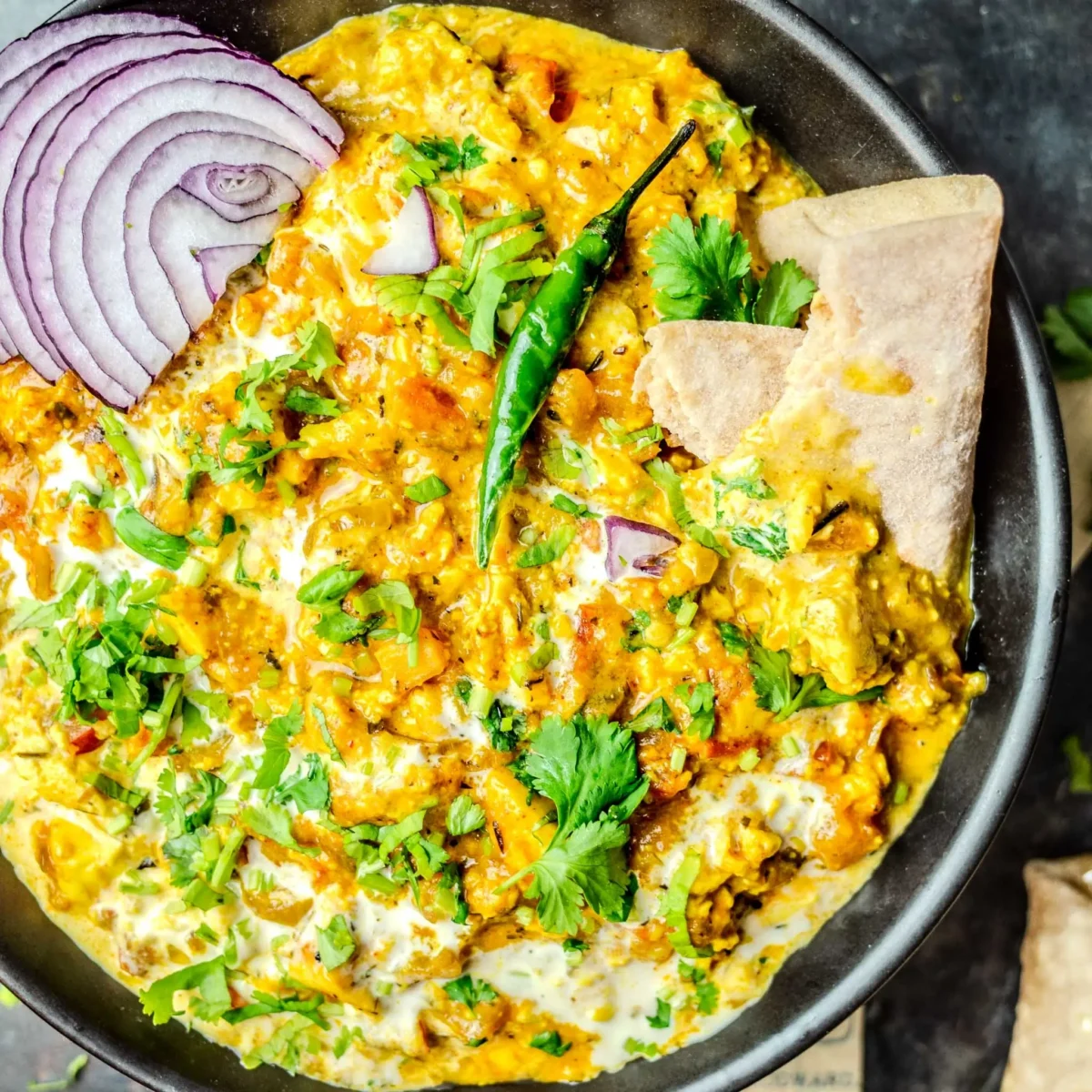
That mouth-watering dish above? Yep, that one there — it’s 100% my go-to paneer dish. I never thought I’d say it, but Amritsari paneer bhurji has officially outranked dhaba-style palak paneer and even paneer butter masala. It’s on my dinner table at least once a week, and is probably my most frequently cooked paneer recipe.
I actually have my dear friend to thank for this recipe. She married into a lovely Punjabi family and regularly travels to Amritsar.
She tried this paneer bhurji from a ramshackle street food place not far from the Golden Temple. As soon as she took a bite, she knew I’d love it, so she scribbled down the flavours, sent photos to me, and insisted that I had to re-create “the paneer dish that changed everything” for her.
And re-create it I did.
The street version has more oil (like … a lot more oil), and it’s typically served with white bread slices, rather than roti. But everything else? It’s spot on. Authentically Punjabi. A taste of Amritsar, from anywhere in the world.
It was one of the best gifts she’s given me, and now I’m sharing it with you, my readers!
Key to the Amritsari paneer bhurji is yoghurt, which lends a beautiful counterbalance to the warm, comforting spices, with just a hint of sourness and a richness that doesn’t dull the fire.
Our next secret is besan (chickpea flour). It’s not just about the nutty flavour; it also thickens our gravy, making it perfectly scoopable and utterly luscious. And don’t even talk to me about the crumbled paneer itself … all I can say is yum yum yum, get in my tum!
❓What is Amritsari Paneer Bhurji?
Amritsar is a city in Punjab (India). It’s perhaps most renowned for the stunning Harmandir Sahib (Golden Temple), one of the holiest sites in Sikhism. “Amritsari” refers to the traditional cooking style popular in the city. The restaurants are known for their liberal use of butter and cream, which they use to make dishes like kulcha, palak paneer paratha, dal bukhara, and Amritsari lassi.
“Bhurji” means “scrambled” in Hindi, alluding to the cooking method. In this case, that’s “scrambled” (grated/crumbled) paneer.
The original dish is anda bhurji (Indian scrambled eggs). Eggs aren’t considered vegetarian in India (unlike the rest of the world), so paneer bhurji was born as a vegetarian alternative.
I regularly demolish anda bhurji for breakfast, but paneer bhurji is a different beast — much richer, more substantial, and infinitely more indulgent.
People make paneer bhurji in various ways; some prefer the dish almost completely dry, where the crumbled paneer has soaked up all the flavours of the spices. Others prefer paneer bhurji with a home-style gravy.
This Amritsari version is a street-style, luxurious approach: rich, saucy, and guaranteed to make you question why you ever settled for basic restaurant paneer (seriously, once you’ve had this, you’ll say goodbye to curry houses forever).
😍 Reasons To Make Amritsari Paneer Bhurji Right NOW!

🍅 Ingredients You’ll Need For Amritsari Paneer Bhurji
This recipe relies on building flavour through careful layering: aromatic base ingredients, a powerful blend of spices, yoghurt to enrich, and the clever use of besan to create that characteristic Amritsari richness.
You’ll need a fair number of ingredients to achieve my perfect street food match, but it’s worth it — a few pantry staples, some essential spices, fresh Indian cheese, and a handful of herbs is all it boils down to.
- Oil: Just 1 tablespoon for the base keeps things from sticking without making it heavy.
- Butter: Adds that essential richness and authentic dhaba flavour that oil alone can’t provide.
- Onion: The foundation of most great Indian dishes — provides sweetness and body to the sauce.
- Garlic cloves: Five cloves might seem generous, but garlic is crucial for authentic Punjabi flavours. It’s buttery, sweet, and oh-so-good.
- Ginger: Fresh ginger adds warmth and helps balance the richness of the yoghurt and butter.
- Tomatoes: Three tomatoes create the tangy backbone that balances the rich spices beautifully. They also add body to our sauce.
- Besan (gram/chickpea/garbanzo bean flour): This is the secret weapon — it creates that uniquely nutty aroma and wonderfully thick, robust sauce that clings to the paneer.
- Paneer: 400g is generous but necessary — this is the star ingredient, after all. You can use fresh homemade paneer or store-bought paneer.
- Spices: It’s not an Indian dish without spices! I use red chilli powder for heat and colour, coriander for an earthy, citrusy balance, turmeric for peppery notes and hue, cumin powder for its warm, comforting, toasty flavour, garam masala for depth and complexity, and a pinch of cardamom powder for a floral, aromatic finishing touch.
- Kasuri methi (dried fenugreek leaves): Adds a distinctive smoky, slightly bitter note that’s essential for authentic flavour.
- Yoghurt: Rich and slightly sour, this ingredient is the secret difference between plain ‘ole paneer bhurji and Amritsari paneer bhurji.
- Cream: A drizzle to garnish the dish is optional, but I simply can’t do without it. This adds that restaurant-style flourish and deliciously rich flavour.
You’ll also need water to adjust the consistency of the gravy (I give exact amounts in the recipe card!), plus salt to season and fresh coriander (cilantro) to garnish your dish.

Cooking for Allergens and Dietary Requirements
For vegan and dairy free paneer bhurji, replace the paneer with firm tofu (pressed and crumbled). Swap the dairy yoghurt for soy, oat, or coconut yoghurt (unflavoured and unsweetened). Use plant-based butter (I like Miyoko’s cultured vegan butter [U.S.] or Flora plant butter [U.K.]) and skip the cream or use a vegan alternative like Flora plant cream double. The flavours work brilliantly with tofu, which absorbs all those layered seasonings.
Gluten-free cooks are in luck — this recipe is naturally gluten-free as besan is made from chickpeas. Just ensure your garam masala blend doesn’t contain any wheat-based fillers (most pure spice blends are fine).
Otherwise, this Amritsari paneer bhurji is 100% vegetarian, nut free, alcohol free, and soy free (if you don’t use soy-based products to make the dish vegan). It’s also halal and kosher-friendly by default.
Substitutions and Variations
- Can’t find fresh paneer? It’s very easy to make at home — all you need is milk and acid to curdle it (vinegar or lemon juice will do just fine). Once the whey separates, you’ll need to pass it through a cheesecloth and then use a tofu press to condense the curds into a block.
Alternatively, you can use tofu (great for vegans) or halloumi (reduce salt elsewhere in the recipe). Tofu absorbs spices better than halloumi. - Grate the paneer instead of crumbling it for a creamier, less rustic version of the dish. Often, I grate half the paneer and crumble the other half; this offers the best both worlds! I use a standard cheese grater to do the job.
- Add a few vegetables to help you reach your 5-a-day goal. A handful of finely chopped green bell peppers (capsicum) or a sprinkling of peas both work nicely without overshadowing the paneer. Add the veggies right before crumbling in the paneer.
- Add a spice blend like pav bhaji masala in addition to garam masala for a street-food touch and more depth of flavour. Start with just one teaspoon and see how you like the effect!
🧑🍳 How to Make Amritsari Paneer Bhurji (Step-by-Step Photos)
Amritsari paneer bhurji follows the winning formula of most Indian curry dishes: fry the aromatics (onion, garlic, ginger), add tomatoes, cook down, fry off spices, add liquids, and thicken.
This recipe also requires you to make a special spiced variation of a French roux with chickpea flour, and later whisking in yoghurt for tangy richness.
These stepwise photos should help you achieve a mouth-watering dish that looks and tastes just like mine:

One: Heat oil and butter in a large pan. Once the butter has melted, add chopped onions, garlic, and ginger. Mix well and cook until the ingredients have softened and become aromatic.

Two: Add the besan (chickpea flour) to the same pan and immediately stir it into the fats.

Three: Continue cooking the besan until it turns nutty and aromatic. Continually stir the mixture to avoid any burning; this can make the dish bitter.

Four: Add tomatoes to the pan along with salt (I’ve found this helps soften them quicker!)

Five: Next, add the red chilli powder, coriander powder, cumin powder, and turmeric powder. Mix into the base.

Six: Cook until the spices are no longer raw and the mixture becomes thick and jammy, with a little visible oil coming out from the sides.

Seven: Add yoghurt and water to the pan.

Eight: Stir in, and continue to cook over low heat, letting those flavours infuse.

Nine: Crumble the paneer using your hands. If the paneer is shop-bought and harder to crumble, use a large grater.

Ten: Add the crumbled paneer to the gravy, which should have oil rising to the surface. Stir in and keep to a simmer.

Eleven: Crush dried fenugreek between your palms and add to the bhurji.

Twelve: Finish with cardamom powder and garam masala. Stir in, check for seasoning, and serve.
Remember, the complete recipe (with ingredient quantities and instructions) can be found at the bottom of this page. You can also print the recipe, save the recipe, adjust the servings, and much more from there!
✨ Top Tips for Perfect Amritsari Paneer Bhurji
Considering I eat paneer bhurji almost every week, I’ve had a lot of practice. And while all the plates tasted fantastic, some were leagues above the rest.
Here’s what marks the difference between everyday and absolutely divine Amritsari paneer bhurji:
- Cook the besan (chickpea flour) thoroughly. It’s the same premise as a roux; raw flour tastes terrible and has the potential to ruin your whole dish. Gram flour is naturally aromatic, so you’ll have a good indication that it’s been properly cooked out when it starts smelling gloriously nutty. Those 2-3 minutes make all the difference.
- Use fresh tomatoes! Canned (tinned) tomatoes really overpower the dish. Obviously, in-season tomatoes will provide the best results.
- Cook until the oil releases. This is the secret to great street food-style dishes. After you’ve cooked the tomatoes until they’re soft and jammy, you should begin to see fat separating from the aromatic base of your bhurji. This is your sign that everything has gone well!
- Avoid overcooking the paneer. Paneer can go rubbery — especially store-bought stuff. Simmer and reduce your gravy, then add the paneer. Cook it for just long enough so the cheese absorbs those beautiful flavours you’ve built. That’s the key to tender, creamy paneer.
- Crush the kasuri methi between your palms. This is VITAL. Crushing the dried herb releases significantly more flavour than adding it as-is.
- Taste! All chefs and home cooks worth their salt taste their food. Seasonings and spices vary considerably depending on age and storage, so taste and adjust to your preference.

🥡Storing Amritsari Paneer Bhurji
This paneer bhurji with gravy keeps beautifully in the fridge for up to 4 days in an airtight container. The flavours improve overnight as everything melds together — I always make extra on purpose so I can have leftovers! Foresight is a wonderful thing when it comes to food 🤭
Paneer recipes generally freeze very well. However, since this dish contains yoghurt, it can separate and become grainy once defrosted. If you do need to freeze Amritsari paneer bhurji, I recommend making it sans yoghurt and adding fresh yoghurt to the dish after freezing. It can be frozen for up to 3 months in portion-sized containers, then thawed overnight in the fridge.
Reheating is best done slowly on the stovetop rather than in the microwave (which can make the paneer rubbery). You’ll likely need to add a splash of water to loosen the gravy. Top with fresh coriander for a little refresh.
🍚 Serving Suggestions For Amritsari Paneer Bhurji
Order this dish from a street food cart in Amritsar, and you’ll likely find it served on a steel thali plate with a slice of thick white sandwich bread. There’s usually raw radish and onions on the side, plus a dollop of green chutney and tamarind chutney. If you want street-style eats at home, that’s the way to go.
However, I also think paneer bhurji is a natural match for pav — like paneer pav bhaji and misal pav, the fluffy bread rolls are incredible at mopping up all the juicy spices.
More home-style options are chapati/roti (pictured in my photos!), or triangle paratha. Garlic and coriander naan is a step above and really can’t be beaten.
I’ve even stuffed the creamy curry into pita pockets before — it’s the perfect picnic or road trip meal.
Not a fan of bread? I’d go for jeera rice with a quick salad (either chopped cucumber, tomatoes, and red onions, or a methi gholana).
I usually eat paneer bhurji with gravy as a hearty dinner-time dish, but it’s really designed to be a breakfast plate … and I have to admit it’s excellent on toast!
If you tried this Amrtisari paneer bhurji recipe — or any other recipe on my website — please leave a 🌟 star rating and let me know your thoughts in the ✍️ comments at the bottom of the page. Thanks for being a part of my community!

🥘Amritsari Paneer Bhurji Recipe
Ingredients
- 1 tablespoon neutral oil
- 1 tablespoon butter
- 1 medium onion finely chopped
- 5 cloves garlic minced
- 1 inch ginger minced
- 1 ½ tablespoons chickpea flour (besan/garbanzo bean flour)
- 3 medium tomatoes finely chopped
- fine sea salt to taste
- 2 teaspoons red chilli powder
- 1 teaspoon coriander powder
- ½ teaspoon turmeric powder
- ½ teaspoon cumin powder
- 300 ml water
- 4 tablespoons yoghurt
- 400 g paneer crumbled
- 1 tablespoon dried fenugreek leaves (kasuri methi)
- 1 pinch garam masala
- 1 pinch ground cardamom powder
- 2 tablespoons double cream to serve, optional
- 1 handful fresh coriander (cilantro), chopped to serve, optional
Instructions
- Heat 1 tablespoon neutral oil and 1 tablespoon butter in a large kadai or deep-sided frying pan over medium flame.
- Once the butter melts, add 1 medium onion (finely chopped), 5 cloves garlic (minced), and 1 inch ginger (minced). Sweat off the aromatics until they've softened, around two minutes.
- Add 1 ½ tablespoons chickpea flour to the pan and cook, stirring constantly, for around 2 minutes. The chickpea flour should let off a beautifully nutty aroma and turn slightly golden once cooked.
- Next, add 3 medium tomatoes (finely chopped) along with fine sea salt (to taste), 2 teaspoons red chilli powder, 1 teaspoon coriander powder, ½ teaspoon turmeric powder, and ½ teaspoon cumin powder. The juiciness from the onions stops the spices from burning. Mix well and continue to cook for 5 minutes, stirring regularly, until the tomatoes have softened and the mixture has become jammy. Oil should separate from the sides of your gravy.
- Pour in 300 ml water and 4 tablespoons yoghurt. Mix well and turn the flame to medium-low. Let the mixture simmer until thickened, a few minutes.
- Roughly crumble 400 g paneer and add to the pan. Stir in.
- Rub 1 tablespoon dried fenugreek leaves between your palms to release the aroma, then add to the pan along with 1 pinch garam masala and 1 pinch ground cardamom powder. Mix these into the Amritsari paneer bhurji and turn off the flame.
- Finish the dish with 2 tablespoons double cream drizzled on top and 1 handful fresh coriander (finely chopped) sprinkled over, then serve.

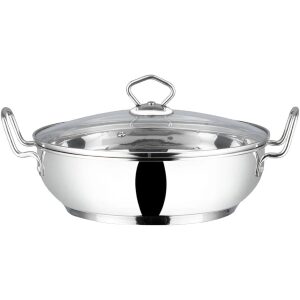
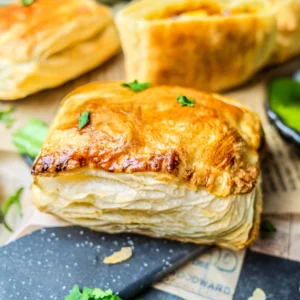



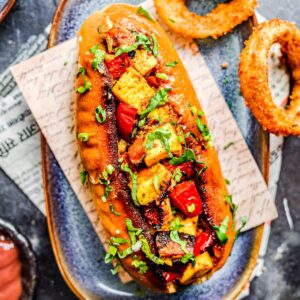
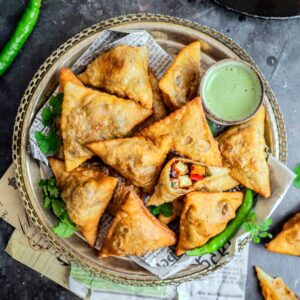
I’m always looking for gluten free recipes that are full of flavour and this didn’t disappoint. Tasted really authentic, easy to make and ideal for a packed lunch.
Woohoo! I’m thrilled the Amritsari style paneer bhurji was easy to make and lived up to your expectations 🙂